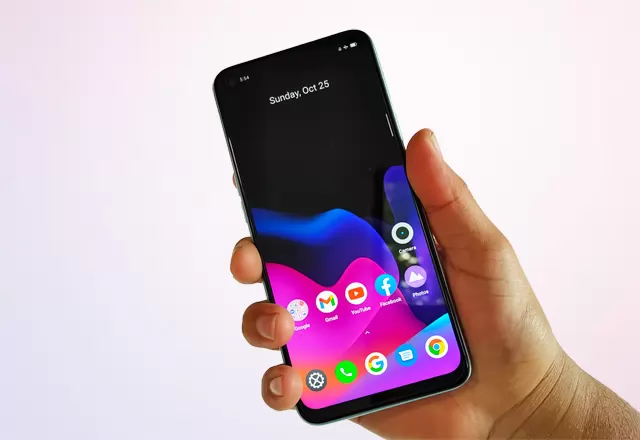
Meet the realme 7 smartphone!
The realme 7 is a mid-range gaming smartphone with a 90Hz display, Helio G95 chipset, 8GB of RAM, and 5000mAh battery.
I’ve used the device for a whole month and this is my full review. Let’s identify its advantages and disadvantages in terms of design, gaming performance, camera quality, multimedia experience, and battery life.
The realme 7 comes in two color options – Mist Blue and Mist White. Both have a subtle vertical band on the left portion of the plastic back cover highlighting the tall camera module.
Its back cover has a slightly matte texture but remains reflective with a few sheens. It doesn’t attract a lot of fingerprints but smudges can still accumulate.
There’s a side-mounted fingerprint scanner embedded on its power button while the volume buttons are on the opposite side. Its SIM card tray is accessible above those while the 3.5mm audio jack, USB Type-C port, and loudspeaker are all at the bottom of the device.
Holding the phone feels solid and sturdy but it lacks the premium vibe of glass-clad smartphones. It doesn’t stand out in terms of design but the build quality seems excellent.
On the front of the realme 7 smartphone is its 6.5-inch FHD+ display with a 90Hz refresh rate and a single punch-hole for the selfie camera.
The screen itself can get bright enough but still struggles when used under the noon-time sun. It does have decent color saturation and responsiveness while the high refresh rate makes it feel smoother than the usual 60Hz displays.
The loudspeaker is a big disappointment though. It sounds tinny even at low volume. Music listening should be through earphones or a Bluetooth speaker.
The realme 7 impressed me with its gaming performance. It’s powered by a MediaTek Helio G95 chipset and 8GB of RAM.
It scored 59 fps on Mobile Legends, 60 fps on Call of Duty Mobile, and 30 fps on PUBG Mobile. These gaming tests were all conducted at high graphics quality using GameBench Pro to measure the average frame rate. Here’s a more detailed realme 7 gaming review.
To enjoy the high refresh rate feature, supported games should be set at low graphics quality. NBA 2K20 can be played at 69 fps. However, there are only a few games that support the feature as of now.
Here’s the realme 7’s RealPi benchmark score compared to other smartphones. The app measures how long it takes for the phone’s CPU to compute 1 million digits of Pi (π). Hence, shorter scores are better.
| Smartphone | RealPi Benchmark Score | |
|---|---|---|
| Huawei nova 5T | 1.82 s | |
| realme 7 | 2.75 s | |
| realme 6 | 3.06 s | |
| OPPO A9 2020 | 3.39 s | |
| Huawei Y7p | 3.62 s | |
| Huawei Y9s | 3.77 s |
In terms of general performance, the realme 7 breezes through different apps. Scrolling down Facebook, watching YouTube videos, and taking pictures are all buttery smooth.
It seems like realme has successfully optimized the realme UI software for the MediaTek Helio G95 chipset. There are virtually no lags nor stutters when using the realme 7.
The realme 7 has quad rear cameras composed of a 64 Megapixel main camera, 8 Megapixel ultra-wide camera, 2 Megapixel macro camera, and 2 Megapixel depth sensor. It also has a single 16 Megapixel selfie camera.
Most pictures from the main rear camera look good when taken in ideal lighting conditions. The software processing makes the pictures pop although it can sometimes look oversharpened and oversaturated especially if the Chroma Boost feature is turned on.
Low-light shots are best taken with Night Mode which results in brighter pictures. It needs several seconds to complete a shot but the wait is worth it.
However, the ultra-wide camera is worse than the main camera. It can be used to take a larger scene or fit more people in the frame but the resulting picture is noticeably darker.
On the contrary, the selfie camera takes bright and detailed selfies. The AI Beauty feature can be used to slightly smoothen faces as well as several additional tweaks.
The realme 7 can also shoot up to 4k@30fps videos with decent quality. Lowering the resolution to 1080p@60fps results in better-looking videos. An electronic stabilization feature called Ultra-steady makes them smoother but reduces the framerate to 30fps.
The realme 7 is a dual-SIM 4G LTE smartphone with dedicated SIM card slots and a separate microSD card slot. It can provide high-speed mobile data connection but it’s highly dependent on the area’s signal coverage.
Meanwhile, the device supports both fingerprint biometric unlocking and face recognition. The power button doubles as a fingerprint scanner in an easily accessible location.
A massive 5,000mAh battery powers the realme 7 and easily lasts more than a day on normal usage.
It scored 13 hours and 9 minutes on the PCMark Battery Life Test 2.0 which is slightly above average. Based on the graph, the device didn’t throttle down its performance from start to finish, unlike other smartphones.
It also supports up to 30W of charging rate using realme’s Dart Charge technology. It only takes less than 30 minutes to reach 50% battery capacity and a little less than 1 hour for a full charge.
The realme 7 is an impressive mid-range smartphone for its gaming performance. It also has decent camera quality, a smooth 90Hz display, and above-average battery life.
My only issue with the device is the poor sound quality of its loudspeaker. This can be easily solved by using earphones or a Bluetooth speaker.
At ₱14,990 SRP, its main competitors are the Samsung Galaxy A31, OPPO A92, and vivo V19 Neo, and Xiaomi Redmi Note 9 Pro. None of these offer a 90Hz display.